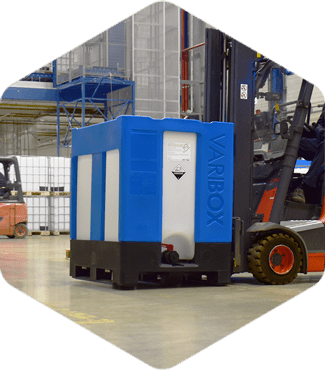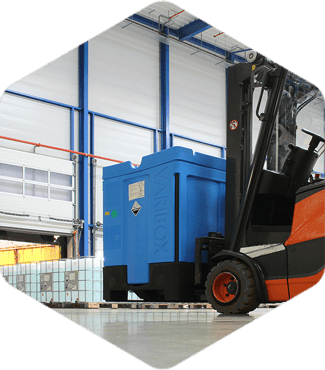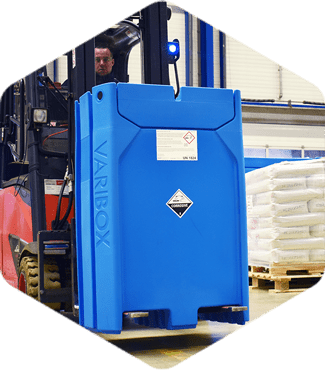Reusable packaging in the chemical industry
Reusable packaging in the chemical industry – For decades, shipping companies have been optimizing the shipping process. Manufacturers and distributors have been able to ship goods in lightweight, strong and cost-effective containers. The desire for standardization led to the Intermediate Bulk Container or IBC that have influenced many industries like the food, beverage and chemical industry. Within the chemical supply chain, it has been seen that Intermediate Bulk Containers of 1000 litres or 275 Us Gallons are commonly used.
When handling hazardous chemicals by road, by rail and on the sea, respectively, ADR, RID and IMDG regulations are to be followed. These strict regulations are all following the United Nations (UN) directives and are effective globally. In the case of hazardous chemicals, IBCs are often put under a lot of pressure. That is why it is important to use safe and durable packaging when handling chemicals, especially hazardous chemicals.
Single-use IBCs used more than once
Most industrial firms are aware of the “standard” IBC, a plastic inner container, manufactured by blow moulding, and surrounded by a steel cage. These are designed for single or limited-uses, generally equipped with a budget butterfly valve and pallet.
In the past decades, the chemical industry has seen recurrent behaviour related to standard IBCs. There is a habit of using standard IBCs more than once after it has been returned.
It can be seen that the more a standard IBC is handled, the shorter its active life will be. Indeed, these standard IBCs have been designed for single-use and are very good for it. However, when standard IBCs are used more than once, it tends not to last as long as a reusable IBC alternative would. Often, users see weakness on the butterfly valve, light-duty pallet, corroded cages… When reusing standard IBC, a company takes risks regarding safety, as the packaging has not been designed to last trips after trips. Additionally, it creates packaging waste that could be avoided if the right product is used for the right business model
This behaviour appears not to be in line with new sustainability directives and policies e.g. Extended Producer Responsibility(EPR). The market need for sustainable alternatives and the desire to shift away from single-use plastic packaging motivates individuals, employees and companies to seek different solutions.
We are seeing a growing demand for robust IBCs that are safe, hygienic and fit for reuse even with tough handling among the supply chain.
Reusable packaging within the chemical industry
Here we can compare the “standard” IBC to its reusable alternative. The reusable alternative to a “standard” IBC is designed to be reused intensively for a useful life of up to 10 years. To clarify, we define the circular economy strategy of reuse as follows: reusing a product for the same purpose, in its original form, and without altering or enhancing it. We can apply this strategy to industrial packaging like IBC used for hazardous chemicals in their liquid form.
A great example of reusable IBCs to look at, are the VARIBOX SC and VARIBOX FC. These are reusable alternatives to the standard IBC that follows the previously mentioned definition of a reusable product. What makes a product reusable? Reasons, why packaging is designed for reuse, include but are not limited to:
- VARIBOX products are of high quality and last longer than the “standard” IBC alternative. Designed for intensive usage for up to 10 years.
- The VARIBOX IBCs have an all-plastic design, that guarantees a “rust-free” corporate image expressed by packaging.
- Wall thickness, material choices, roto-moulded parts combined in several versions, and long-lasting and leak-free equipment provided with the container itself… are some of the differentiation aspects that characterize an IBC designed for reuse.
In Europe, reusable IBCs were introduced, in 1970, by a company now known as VARIBOX. It started with roto-moulded plastic inner containers surrounded by a strong metal frame: the “VARITAINER” and “MULTI BOX” IBC, which were later followed by an all-plastic design. Reusable IBCs used for chemicals all have one point in common: their production technique. Indeed, these are produced by rotational moulding, it provides reusable IBCs with a high mechanical and chemical resistance. This manufacturing technique is used to manufacture durable products and packaging that are to be reused intensively in a harsh environment like the chemical industry.
Benefits of Reusable packaging for different stakeholders
Using IBCs, that have been designed for reuse brings different benefits to different stakeholders. While thinking about the main stakeholders, we think about chemical distributors, end-users, the environment and the government.
For chemical distributors, that usually keep ownership of the packaging, purchasing reusable IBCs leads to benefits in terms of:
- Packaging material cost reduction, due to the longer useful life of reusable packaging, costs are spread over many years. This results in a smaller cost per trip. Quality improvements, reusables are more durable and have stronger packaging than the single or limited-use alternatives. This prevents product damage from packaging failure and improves operational safety.
- Additional workers’ safety is brought by reusables, like automatic venting decrease the chances of inhaling fumes or entering in contact with hazardous chemicals.
- Customer loyalty is due to the reliability of the deliveries and the packaging it is shipped in.
Other important stakeholders include end-users of the products carried in reusable IBCs. These are driving the demand and need to be satisfied, they benefit from:
- No IBC end-of-life management, because the chemical distributor keeps ownership of reusable IBCs, the end-user does not engage in managing its end-of-life. It results in cost savings.
- Less loss of product, due to the improved due to improved quality and durability of reusable IBCs.
- Hygiene improvements, in locations where it is a prominent requirement e.g. brewery industry, food & beverage industry, pharmaceutical industry… due to the all-plastic design
Environmentally, reusable IBCs are of great interest. The environment is an important stakeholder in any business transaction and every other stakeholder benefit from a durable and protected environment:
- With reduced waste management, reusable IBCs are provided with almost zero residual in the inner container. It results in less hazardous waste to manage after usage of the IBC.
- Reusable IBCs help Chemical distributors and end-users reach their internal sustainability


